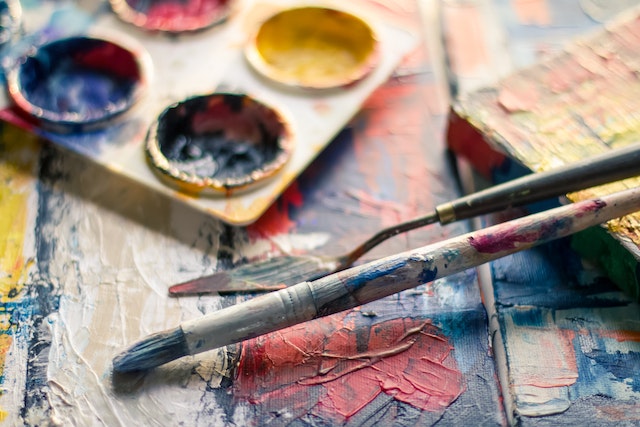Whether it’s simply to express yourself or start a side-hustle in the art world, one of the best ways of showcasing creativity is through the visual arts. To start, let’s find out the different kinds of acrylic paints.
Types of Acrylic Paint
Heavy Body Acrylics
Heavy body acrylic paint is a type of paint with thick viscosity. Instead of using a paste additive to regular acrylic, the thick viscosity of this type allows the painter to retain texture to add some 3D depth to the image. Impasto painting, if you have not yet heard of, is where this is useful. The best brush to use with this type of paint are those that are stiff, a palette knife is also a good way to essentially sculpt the paint onto the painting surface.
Soft Body Acrylics
Soft body acrylics is the most commonly used, and is likely what you will start with as a beginner. This has the consistency of cream. Depending on the quality and brand, the pigment strength can vary. Always make sure to read the labels when buying tubes, some brands can indicate if the paint is transparent or opaque. This will make a huge difference in the final result of your artwork.
Soft body is probably the most versatile since there are many additives you can use to modify its behavior on the canvas. The aforementioned paste additive is one example. Another is an acrylic retarder. A major behavior of acrylic is it dries very fast. You only have minutes before the paint dries and blending on the canvas will be impossible, and this can be very frustrating if you are a beginner and are not use to painting fast. Thankfully, this additive increases the time before the paint will dry by a few more minutes.
Painting with acrylic usually leaves a glossy surface and can be distracting when viewing the image from certain perspectives as opposed to oil or acrylic gouache that are matted by default.
Acrylic Inks
If you fancy acrylic painting without brushes then acrylic inks is the way to go. The artist pours the liquid onto a canvas or some other surface and manipulates the flow by tilting it or using other methods to simulate motion. The kinetic motion, swings the paint around to form abstract images. Acrylic inks can also be used for spray painting.
Slow Drying Acrylic Paint
Adding retarders to your acrylics help but they can only do so much to delay the drying time. A true slow drying acrylic paint is one from the brand Golden Open Acrylics that provides hours of delay before the paint will become too dry to blend.
Acrylic Gouache
Acrylic gouache can be described as the combination of characteristics between opaque watercolor (original gouache) and acrylic. When painting with acrylic gouache, the finishing image will have a matte finish with a water-resistant surface.
Various Mediums or Additives
Matte Finish/Varnish
This is simply a liquid varnish that is applied to the whole painting after allowing it to dry for a few hours or days. Using a wide flat brush, the varnish is painted horizontally first then vertically or vice versa. This finish will reduce the glossiness of the painting and will protect it from UV damage over time.
Glossy Finish/Varnish
This liquid varnish will enhance the glossiness of the painting and protect it from UV damage over time.
Acrylic Retarder
Reduces the drying time, giving the painter more time to work on blending. A drawback to using this is it can slightly dilute the intensity of the color. This is mixed in with the paint before applying on the canvas. Adding too much can dilute the color so make sure to read the instructions of how much you need to add.
A note about retarders is it may contain toxins that are harmful to your health. An alternate solution to keep the paint moist is to spray the palette with water once in a while or use a wet palette.
How to Build a Wet Palette for Acrylic Painting
To construct a wet palette, lay oil paper on top of several layers of damp paper towel. The moist from the paper towel will go up to keep the paint from drying out while the oil paper keeps the paint from being absorbed by the paper towel. If you still have some left over paint or need to take a break, you can use a plastic file case to enclose your wet palette to keep humidity in. In fact, you can use a spare plastic file case as your palette. Other alternatives like lunch boxes work too.
Gloss Medium
Not to be confused with the varnish, this is a medium that is mixed in with the actual paint to increase its glossiness. However, this will also dilute the intensity of the color so be aware of how much to add. Always read the instructions on the label to know exact ratio.
Matte Medium
Opposite of the Gloss medium, this will reduce the glossiness of the paint and will also have the same effect of diluting the color intensity.
Semi-Gloss Medium
As the name implies, it will try to balance your glossiness to matte ratio.
Fluid Medium
If you find the consistency of the paint too thick or the paint is not adhering well to the canvas, a fluid medium increases the fluidity of the paint to allow it to flow and get into nooks and crannies, giving the stroke a more solid color. Usually, painters use water to do this but using water dilutes the binding agent that keeps the pigment together, making the applied paint flake off over time. This medium will prevent that from happening.
Modeling Gel
A white cream that is added to the paint to increase its viscosity. You can turn soft body acrylic into heavy body without buying the real thing. This requires a palette knife or a stiff brush to sculpt it onto the canvas.
Gesso
Gesso is a gel that is applied as a primer on a new canvas, this helps the paint grab onto the surface better and will keep it on the surface instead of being absorbed into the canvas. This is applied usually 24 hours before painting to make sure it’s dry all over.
Paint Thinners
Fortunately, you don’t need them for acrylics.
Brushes

When looking at brushes, the first thing that is noticeable with them is the head. The head determines what kinds of strokes you can paint. Some for putting on solid colors like in blocking sections of a paint and the others in creating details.
Flat Brush
Great for blocking areas at the beginning of the painting process. Larger brushes of this type are used for creating skies for landscape paintings. Depending on the size, you can paint lines, edges, or full shapes.
Filbert Brush
Depending on your style and preferences, a filbert brush is an all around brush that will work for all sorts of situations but for the most part it is used for creating soft edges. It combines both a flat brush and rounded brush for better versatility.
Rigger or Liner Brush
When painting intricate details like grass or hair, it is still possible with something like a small flat brush but it can be tedious. A liner or rigger brush what you will need for painting thin lines. It can be used also for calligraphy. The brush is long that tapers to a pointed tip.
Angular or Dagger Brush
The angular or dagger brush has a sloped edge that allows for painting curved or straight lines. Corners can be tricky and thus this type of brush is the preferred tool for that. It can double as a flat brush or for detailing, depending on how you hold the brush or which part of the edge you use.
Fan Brush
A fan brush spread outward like a broom and is very useful when painting grass or foliage, and for making soft strokes under dry brushing.
Synthetic Brushes or Natural Brushes
The brushes above fall under two main categories: Synthetic and Natural. Which one should you use for acrylic for painting? It largely depends on your preference but the recommendation is to go with synthetic brushes as they work well with acrylic which is plastic itself. Natural brushes can work too but they are recommended for oil painting.
However, one of the issues with synthetic is that the hairs are too uniform that it reduces any randomness to the texture of the applied paint. This becomes obvious when painting bushes or foliage, the painter has to manipulate the brush in such a way to create random streaks or dots. Natural brushes don’t have this as much an issue, however.
Brush Care
A common habit for painters is to leave their brushes soaked until the next painting session. This is a bad habit that should be avoided. The best way to care for brushes, whether you are in oil or acrylic, is to wash them thoroughly after use then leave them to dry.
When paint is left on the fibers, over time the paint will gunk up deeper into the crimp and ruin the shape of the brush.
One of the tips floating around is to never mix your brushes between oil and acrylic. If you started to use oil for a brush, it should be used for oil forever, the same goes for acrylic.
Other Painting Surfaces
Unlike oil, acrylics dry into a rubbery or plastic surface, this makes it water resistant, making it very versatile when it comes to where it can be painted on. Here are few surfaces acrylic paints can be tried on.
Plywood
Acrylic paint can be used on wood, a very good surface to paint on but not as portable as canvas. However, you need to consider the natural grain of the wood and how it will affect the final image. You could sand it beforehand or add some gesso to fill in those grains. When it comes to budget, plywood can be more affordable, a canvas that has less area than a 4’x8’ feet can be more expensive than a whole plywood sheet. It’s just that you will put in the extra hours to prepare the surface for painting. But as a beginner, you really shouldn’t be bothering with this yet.
Photopaper
This was really an experiment on my part. You can read all about it here. Photo paper can either be glossy or matte in finish. It’s hard to paint with. If you have too much water, the paper will get soaked and can ruin the image.
Concrete
Acrylics can be used to paint on concrete like how murals are done.
Glass
Glass has a smooth surface and therefore will be difficult to paint on, a primer needs to be added first before starting to paint. Never sand glass unless you know what you’re doing. Better still, just apply a primer.
Plastic
Depending on the roughness of the surface, a very smooth surface will also require a primer.
Metals
You can paint acrylic on metal, you just need to deal with rusting issues. You will need to add a metal primer such as red oxide or zinc phosphate. You need to go to your hardware store to find these, not your art supply. After which, you need to layer on gesso or even just regular white paint.
Illustration Board
Certainly more affordable than panel canvas but it comes at the risk of bowing. When acrylic paint dries, it shrinks so the board will bow inwards on the painted side. There are ways to mitigate but if you are just using it to practice, it’s not an issue.
Water Color Paper
Acrylics work on water color paper but it will still have the bowing issue. The result will not also be as sharp. See example below.

Frequently Asked Questions
So As A Beginner in Acrylic Painting Which Medium Or Additives Do You Need?
In my opinion, you only really need the acrylic retarder and gesso. Unless you plan to preserve your very first paintings and display them, you can also include the varnishes.
For the type of acrylic paint, it depends on what type of artwork you want to make. If you want to do regular painting, the soft body acrylic paint will do. If you want to do add some 3D effect, the heavy body acrylic paint is your jam (don’t eat it), or if you want to do some spray painting, then acrylic inks is going to be your choice.
Should You Buy Student Grade or Professional Grade of Acrylic Paint?
The consensus is quite varied between beginners and pros. Going professional immediately eliminates all the struggles of using student grade paint. An example of this is the pigment load. Professional grade paints have more pigment content so they are more intense in color, allowing you to conserve the amount of paint you can use per tube and saves time since it will lessen the amount of layers you have to put in. In short, Professional Grade is more expensive upfront but cheaper in the long run.
Using professional grade paint will also help you avoid bad habits from using lower quality paints.
Cotton Canvas or Linen Canvas?
Cotton canvas is common and can either be in panel form or framed. Linen is more expensive and rare, usually intended for archival purposes. So if you intend to really preserve your painting, use linen. But canvas is still good if taken care of properly, and it is far more affordable for a beginner.
Panel or Framed Canvas?
As a beginner, I find that using canvas panels are great for practice, framed canvases are great too but I’d avoid the big ones just yet, especially since they are expensive. If budget is a concern, you can get a lot of practice from using panel canvas than framed ones. For a single framed canvas, you could probably buy two or 3 panel canvas of the same size.
An advantage of using a panel canvas is you can scan it if you also want to preserve it digitally, specifically if it’s A4, letter size, or smaller. Yes, you can take pictures of large paintings but if you are picky when it comes to image quality, and you don’t exactly have the correct set up or camera, you may not be able to capture the best quality image.
As A Beginner, What is the Best Canvas Size to Start With?
In my opinion, if you are just starting out, it’s best to start with small paintings. A letter-size (8.5 inches x 11 inches) canvas seems like a good start. It’s not too big that you’ll ran out of paint or too small that you won’t be able to practice adding detail. Remember that acrylic dries fast too so you need to learn to work fast first.
Also, if you don’t really have a good idea of what to paint, you will have an area on your canvas, just waiting to be painted on for days. Large paintings can take days to finish, if not for a lack of ideas, adding details will eat up your time. If you are painting landscapes and have a lot vegetation and animals, the longer it will take to finish.
If you are going to use student grade acrylics, you’re going to burn through those tubes fast. So if you are going to commit to a large canvas, you better be sure of what you are going to paint.
Is Acrylic Paint Toxic?
It all depends on what pigment was used on a particular color. Example, Cadmium yellow is likely to contain real cadmium unless it’s specifically indicated by the manufacturer that this is an imitation. Acrylic retarders may also contain toxic substances like formaldehyde which is a carcinogen. You might want to read up more about this. If you are conscious about using mediums like this, you will have to stick with a wet palette or use a mist bottle.
If you will use a spray bottle, spray sparingly. The water will dilute the concentration and weaken your painting.
You can think of acrylic paint as colored glue. So you can imagine that if you put too much water that can cause the paint peel off from the canvas. It may not peel off immediately but over time it will.











